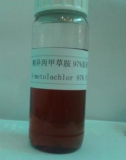(S)-Metolachlor Suppliers, (S)-Metolachlor Manufacturers.
LABOR KAIFENG AGROCHEMICALS CO., LTD.

(S)-Metolachlor
Category :
Agrochemicals/HerbicideSynonyms :
2-Chlor-N-(2-ethyl-6-methylphenyl)-N-(1-methoxy-2-propanyl)acetamid;2-Chlor-N-(2-ethyl-6-methylphenyl)-N-(1-methoxypropan-2-yl)acetamid;2-Chloro-N-(2-ethyl-6-methylphenyl)-N-(1-methoxy-2-propanyl)acetamide;2-Chloro-N-(2-éthyl-6-méthylphényl)-N-(1-méthoxy-2-propanyl)acétamide;2-Chloro-N-(2-ethyl-6-methylphenyl)-N-(1-methoxypropan-2-yl)acetamide;2-Chloro-N-(2-ethyl-6-methylphenyl)-N-(2-methoxy-1-methylethyl)acetamide;51218-45-2;a-Chloro-2'-ethyl-6'-methyl-N-(1-methyl-2-methoxyethyl)acetanilide;Bicep;CAS NO :
51218-45-2EC NO :
257-060-8Molecular Formula :
C15H22ClNO2Molecular Weight :
283.7937Main Specifications :
97%TCInChI :
InChI=1/C15H22ClNO2/c1-5-13-8-6-7-11(2)15(13)17(14(18)9-16)12(3)10-19-4/h6-8,12H,5,9-10H2,1-4H3Packing :
As per customer's request ,20ML-20l for liquid formulations, 1g-25KG for solid formulationsProduct description :
Common Name:
(S)-Metolachlor
Chemical Name:
2-ethyl-6-methyl-N-(1'-methyl-2'-methoxyethyl)-chloroacetylanilide
Pesticide Category:
Herbicide
CAS No:
51218-45-2
Molecular Formula:
C15H22ClNO2
Structural Formula:
Properties
Appearance: Pure metolachlor is light yellow oily liquit
Flash Point: 110-180°C
Vapour Pressure: 0.0017 Pa
Stability: Stable in water, Easy dissolves in alcohol, dichloromethane, benzene, toluene etc. many solvents. Hardly dissolves in ethylene glycol, petroleum.
Mode of Action:
Selective herbicide, absorbed predominantly by the hypocotyls and shoots. Inhibits germination
Characteristics and Uses:
Control of annual grasses and some broad-leaved
weeds in maize, sorghum, cotton, sugar beet,
fodder beet, sugar cane, potatoes, peanuts,
soya beans, safflowers, sunflowers, various
vegetables, fruit and nut trees, and woody ornamentals.
Toxicity:
MAMMALIAN TOXICOLOGY Oral Acute oral LD50 for female rats 1063, male rats 1936 mg/kg. Skin and eye Acute percutaneous LD50 for rats >5050 mg/kg. Mild skin and eye irritant (rabbits). May cause skin sensitisation (guinea pigs). Inhalation LC50 (4 h) for rats >2.02 mg/l air. NOEL (90 d) for rats 300 mg/kg diet (c. 15 mg/kg daily), for mice 100 mg/kg diet (c. 100 mg/kg daily), for dogs 300 mg/kg diet (c. 9.7 mg/kg daily). ADI (EPA) cRfD 0.10 mg/kg b.w. [1995]. Water GV 0.01 mg/l Toxicity class WHO (a.i.) III EPA (formulation) III EC classification (R43) ECOTOXICOLOGYBirds Acute oral LD50 for mallard ducks and bobwhite quail >2150 mg/kg. Dietary LC50 (8 d) for bobwhite quail and mallard ducks >10 000 mg/kg. Fish LC50 (96 h) for rainbow trout 3.9, carp 4.9, bluegill sunfish 10 mg/l. Daphnia LC50 (48
Uses :
selective herbicide before sproutMolecular Structure :

About Us - Top Products- Partner with Us - Contact Us - Help - Sitemap
ChemNet is a registered trademark of Zhejiang NetSun Co., Ltd.
